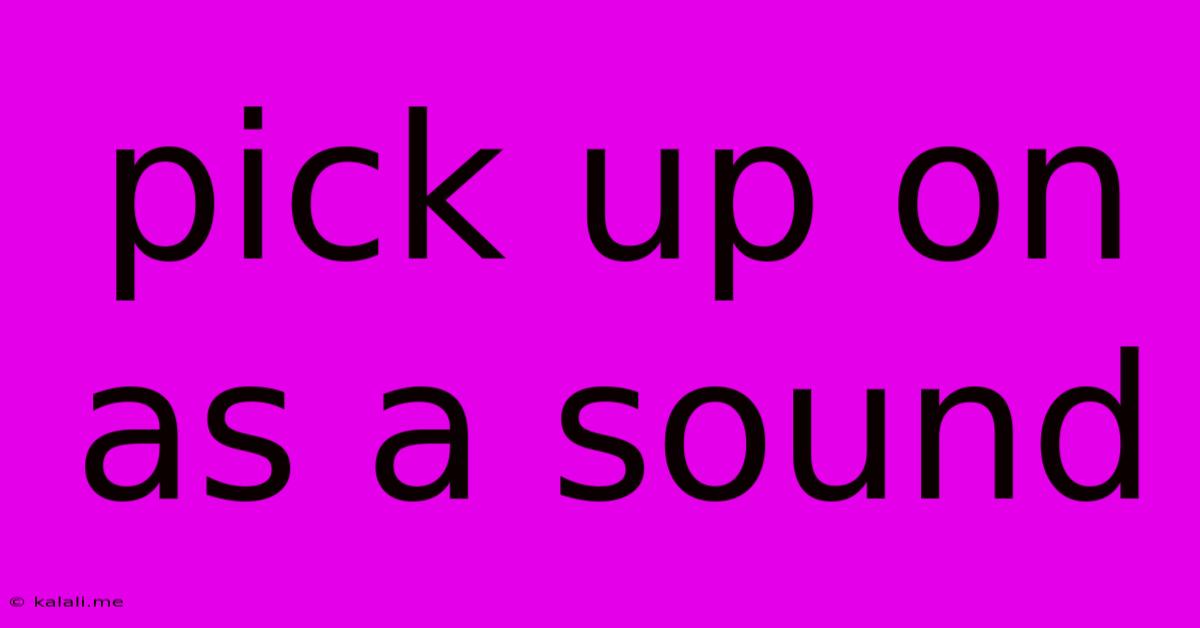Pick Up On As A Sound
Kalali
May 31, 2025 · 3 min read

Table of Contents
Pick Up on as a Sound: Exploring the Nuances of Sound Acquisition and Perception
Picking up on a sound isn't just about hearing; it's a complex process involving auditory perception, cognitive processing, and even emotional response. This article delves into the multifaceted nature of sound acquisition, exploring how we identify, interpret, and react to sounds in our environment. This includes understanding the physics of sound waves, the biological mechanisms of hearing, and the cognitive processes involved in sound recognition. Whether it's the subtle creak of a floorboard or the cacophony of city traffic, understanding how we "pick up on" sounds enriches our appreciation of the auditory world.
The Physics of Sound and its Transmission
Before we can even begin to "pick up on" a sound, we need to understand how it travels. Sound, fundamentally, is the vibration of air particles. These vibrations, originating from a source, propagate outwards as waves. The characteristics of these waves – frequency (pitch), amplitude (loudness), and timbre (quality) – determine the sound we perceive. Different materials absorb and reflect sound waves differently, affecting how sound travels and the quality of what we eventually hear. Understanding these basics allows us to appreciate the complexities involved in how different sounds reach our ears.
The Biological Mechanisms of Hearing: From Ear to Brain
Our ears are remarkably sophisticated instruments, expertly designed to capture and process sound waves. The process begins with the outer ear, collecting and channeling sound waves to the eardrum. The vibrations of the eardrum are then transmitted through the middle ear (malleus, incus, stapes) to the inner ear, specifically the cochlea. Within the cochlea, these vibrations are transformed into electrical signals by hair cells, which are then transmitted via the auditory nerve to the brain. This intricate biological mechanism enables us to not only hear but also discriminate between different sounds and their nuances. Damage to any part of this pathway can significantly impair our ability to "pick up on" sounds effectively, emphasizing the delicate balance required for healthy hearing.
Cognitive Processing and Sound Recognition
Hearing is only the first step. The brain plays a crucial role in interpreting the signals it receives from the ears. This involves complex processes of pattern recognition, memory, and association. We "pick up on" sounds not just by their physical properties, but also by their context. A familiar voice, a recurring melody, or the distinctive sound of a car engine are all recognized based on our past experiences and stored memories. This ability to contextualize sound significantly enhances our ability to interpret and react appropriately to our auditory environment. Furthermore, our brain filters out irrelevant sounds, focusing on those deemed significant – a remarkable feat of selective attention.
The Emotional Impact of Sound
The perception of sound isn't merely a cognitive process; it deeply influences our emotions. Certain sounds evoke feelings of comfort, while others trigger anxiety or fear. The emotional response to sound is often deeply personal, shaped by past experiences and cultural associations. This explains why certain sounds are considered calming (e.g., nature sounds) while others are jarring (e.g., loud noises). Understanding the emotional impact of sound is critical to appreciating the holistic experience of "picking up on" a sound.
Conclusion: The Rich Tapestry of Sound Perception
Picking up on a sound is far more than a simple act of hearing. It's a sophisticated process involving physics, biology, and cognition, intricately interwoven with our emotional landscape. Understanding this intricate interplay enriches our appreciation for the rich tapestry of sounds that make up our world. From the quiet rustle of leaves to the vibrant symphony of an orchestra, the ability to "pick up on" sounds is a fundamental aspect of human experience.
Latest Posts
Latest Posts
-
Flesh And Blood Cannot Inherit The Kingdom Of God
Jun 01, 2025
-
How To Change Strings Of Guitar
Jun 01, 2025
-
Iphone 13 Pro Camera Not Recognized
Jun 01, 2025
-
Does Natural Light Or Light Produce More Heat
Jun 01, 2025
-
How Many Beats Does A Whole Note Get
Jun 01, 2025
Related Post
Thank you for visiting our website which covers about Pick Up On As A Sound . We hope the information provided has been useful to you. Feel free to contact us if you have any questions or need further assistance. See you next time and don't miss to bookmark.